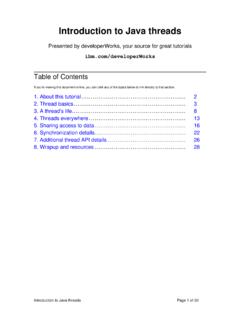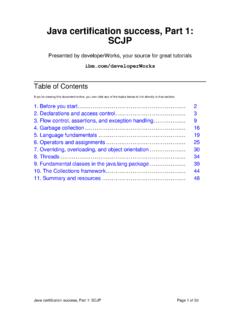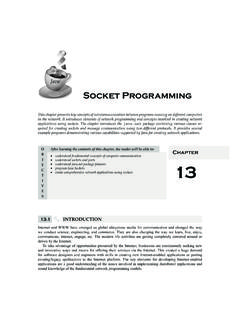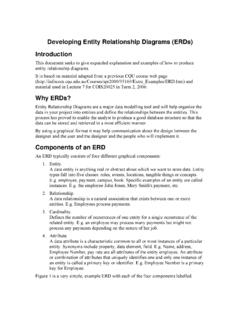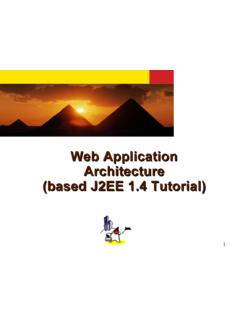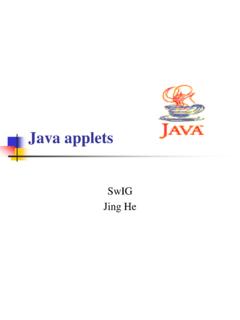Transcription of Struts Tutorial - cogent
1 Struts Tutorial by Stephan Wiesner Struts Tutorial by Stephan Wiesner Copyright 2002 Stephan Wiesner This is a Tutorial for the Struts framework. It consists of a small application which is developed step by step. It can display books in the browser, new books can be created and their state saved/loaded in xml files. I try to do the whole thing step by step, with lots of screenshots to show that it really does work and to help you along. Many of the screenhots actually show error messages. This will help you avoid some of the many pitfalls along the way. This work should enable you to work with Struts in a short time, but you will not become a Struts guru with it.
2 You should have the official documentation at hand to read the theoretical background. This work is closed, I don't think I will continue it's development. Struts Tutorial Table of Contents ..1.. 2. 3. The First Try: Simple JSP .. 3. 4. Second Try: Struts For Internationalisation .. 4.. 9. First Try at Forms .. 9. Struts : Introducing the ActionForm .. 14. A better way to seperate Book and BookForm .. 17.. 18. Recapitualation: Where we are .. 21.. 23. First Try at Logic .. 23.. 24.. 33. 9. Replacing JSP with XSLT .. 37.. 39. 11. Ant for Compilation and Distribution .. 42.. 42.. 42.. 42.. 43..46.. 47. Technical Background of this Document .. 50.. 50.. 52..52. 53.
3 57.. 58..58.. 60..61. iv Struts Tutorial List of Figures .. 2.. 3.. 4. Displaying the German title element .. 6. Reloading a Context With Tomcat .. 7. Nice Errormessages are always close at hand .. 11.. 13. Where is the book? .. 13.. here is one.. 14. Book Creation and Validation .. 16. Our first Error Message .. 20.. 21. ,usingfor-loop .. 23. Our First Template displayed .. 29. Our First Template displayed .. 32. Error Serializing a Bean .. 34. Display the Book as XML .. 38.. 40. AspecjtJ Times your Methods.. 41. ANT doesn't know Struts .. 43. Voila, application running from WAR .. 45.. 51. One World, one Tutorial :-) .. 53.. 54.. 55.. 56. Sorted List of Books.
4 60. v vi Struts Tutorial Chapter 1. Introduction Table of Contents ..1. Abstract Why I wrote the Tutorial , who is the target group and an overview of the contents. To get an idea what this Tutorial is about and whether you should be able to learn something new. Introduction During this Tutorial I will develop a little application, step by step, that implements Struts [ ]. You should have some experience with JavaServerpages, JSP and XML and you should have a server implemented that can run those things. I use Struts Version and Tomcat ; see my homepage [ ] for a Tutorial about installing Tomcat under MS Windows, if you don't have it yet. Please, I keep getting mails (from India mostly), asking me to explain the setup in websphere.
5 I don't have that server and don't intend to get one, so I can't give any specific help for it. The Tutorial will start with the installation of the Struts framework itself, will imple- ment some minimalistic features in pure HTML and will then add Struts funtionality, giving hints and thoughts about how to organize your code. Finally I'll even show you some tricks with AspectJ to make your life as a programmer somewhat easier. About the annotations: From time to time I decide to publish mails send to me about this Tutorial . They are marked as 'Annotation' or 'Remark' (currently DocBook has no elements for annotations, though this feature is under discussion) and are placed at the bottom of the chapter they best fit into.
6 I started this after I already had lots of mails, so many of them are not included (I'm just too lazy, I guess :-). I will continue to do this, so if you don't want that (I just post the name, not the mail address), please state it in your mail. And, please let me know from which country you come. I'm curious about that .. Text marked with '[]' is not part of the original mail but an addition from me (typical [..]). Also take a look at the Chapter 15, Epilogue [50]. chapter about technical backgrounds. It might interest you. Important for Tomcat users: Some code will not work!. Tomcat doesn't allow you to work without a package. At the moment, I am going through it all and update it, but it I might have overlooked somethin.
7 1. Struts Tutorial Chapter 2. Installation of Struts This one is quite easy. I take it, you have a running Tomcat (or comparable server). and know how to handle it? I will not go into detail but all steps necessary to make my examples work are explained. Figure The folder structure Generate a directory structure like in the screenshot (adapt if you don't use Tomcat). Download the newest version of Struts [ ] (I use )1. Extract the download. Copy the Paste it to the lib directory of your application (see above). DON'T, I repeat DON'T just add it to your CLASSPATH! I did that and it worked fine. Until I restartet the Tomcat, that is. Took me quite a while to figure the connection out.
8 At least with my system there was a big problem, so I recommend to add it just to this application. That is all, for the moment. Don't delete the rest of the Struts download, though. We will need more later on. 1. Struts is developing fast, so you if at the time of your reading of this text there is a new version, take my. You can switch to the new one after you worked through the examples. This might save you lots of pain. 2. Struts Tutorial Chapter 3. The First Try: Simple JSP. We will start with a simple JSP page, just to ensure that we did everything right until now. Create a file called in the 'strutsShop'-directory. First JSP. <%@ page language="java" %>.
9 <html>. <head>. <title> Struts Tutorial : BookView</title>. </head>. <body bgcolor="white">. <h2>BookView</h2>. </body>. </html>. Figure Our First Page Not very impressive, I admit, but we will start improving it right away. 3. Struts Tutorial Chapter 4. Second Try: Struts For Internationalisation We will use Struts to display predefined texts in the default language of the user. Well, not for every user, I This will require some closer look at the functionality of Struts . Display the title of the page in different languages. We starts with some basics about Struts : Go to the directory you extracted the Struts download to and copy some files to your WEB-INF directory like in the screenshot (you should browse through a few of the examples that come with Struts , while search- ing for them).
10 Figure Needed LTD files Take the time to look into the file. Don't panic, though, we will not adapt those files! They are there to help us and define the functionality of Struts . You can find the parameters you need for using a Strut tag in there. You could look into the official docu and would probably be better off, though. Our must define an action Servlet and the links to the ltd-files. Just copy one from the Struts sources and remove everything else. Empty <?xml version=" " encoding="ISO-8859-1" ?>. <!DOCTYPE Struts -config PUBLIC. "-//Apache Software Foundation//DTD Struts Configuration ". " ">. < Struts -config> </ Struts -config>. 4. Chapter 4. Second Try: Struts For Internationalisation <?

